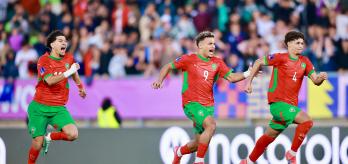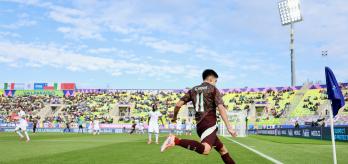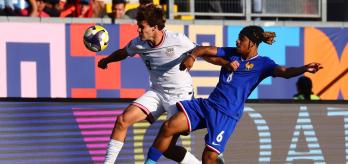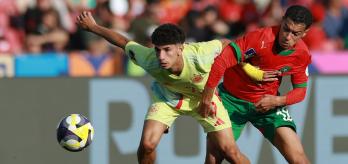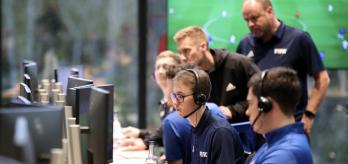It has been observed by our Technical Study Group that goalkeepers are very assertive in the first phase of defensive corners during FIFA U-20 World Cup Chile 2025™, particularly when the ball is delivered directly into the space around the goal area (six-yard box).
As FIFA’s senior football and goalkeeping expert Pascal Zuberbühler explains, “We are seeing that goalkeepers are coming out more when it is feasible to defend these balls. There is only a certain area that goalkeepers can realistically secure the first contact in, and they are very proactive regardless of whether their team is using a player marking, hybrid or zonal setup.”
Goalkeeper positioning and responsibility before delivery
The starting position for a goalkeeper remains consistent when their team is defending a corner, regardless of the defensive setup. The only factor that influences the starting position is whether the delivery will be an inswinger or an outswinger. In all cases, though, the following are constant for goalkeepers:
- have a clear view of the ball;
- judge the height of the ball;
- have patience to read the trajectory before moving;
- maintain an open body shape;
- set a starting position based on inswinger/outswinger;
- ensure the ability and space to claim/interact with the ball in the vicinity of the goal area;
- confirm that team-mates are performing the right roles; and
- ensure communication and timing.
According to Zuberbühler, “For inswingers, the goalkeeper starts closer to their goal line, but for outswingers, you can be a little bit further out. Also, before the corner comes in, the body position of the goalkeeper needs to be open so they can see the ball and the space around them. This is vital, as even this positioning can affect the mindset of the player taking the corner, especially if they can see you are in control of the area they are targeting.
“The goalkeeper must be the coach in the penalty area for set plays. They must ensure everyone is doing their role, especially after substitutions or if something unexpected happens. Many teams vary their attacking corners, and defending teams must be able to reorganise their defence if necessary. Additionally, many teams have set-play coaches, highlighting the work that goes into them.
“Opposition teams will also study the goalkeeper and will target their perceived vulnerabilities. That’s why set-play situations are vital in games because match-defining moments can come from these.”
Attacking player assigned to goalkeeper
If an attacking player positions themselves close to the defending goalkeeper, this must be handled correctly. Some goalkeepers prefer to deal with these 1v1 scenarios themselves, whereas others prefer to have a defender marshalling that attacker, ensuring the goalkeeper has space to move.
For Zuberbühler, there are additional factors that must be considered in this scenario to ensure the goalkeeper can see the ball before the corner is taken.
“If the goalkeeper will deal with an attacker in their immediate vicinity themselves, they must have a clear view of the ball’s trajectory. They also need to understand why a player is standing in front of or behind them, as this may indicate the intended trajectory of the ball, and the goalkeeper needs to work to ensure the attacker’s position does not impede their movements to defend the ball.
“Also, the goalkeeper coach can have an impact if they notice the opposition stationing a tall player in the immediate vicinity of the goalkeeper, as this can impede the goalkeeper’s line of sight of the incoming ball. These things are important when deciding who deals with a player standing in the goalkeeper’s vicinity.”
In clip 1 below, Norway goalkeeper Einar Fauskanger is being marked by an attacking player. Before the ball is kicked, he is close to his goal line, has an open body shape and has a good view. As the inswinger is delivered, he patiently times his response before manoeuvering around the man marker to create space to attack the ball.
Goalkeeper considerations in different strategies
There are some additional factors that a goalkeeper may need to consider, depending on their team’s preferred defensive strategy. Zuberbühler uses the clips below to highlight some of the extra nuances that can arise in player marking, hybrid and zonal defensive setups.
Player marking
Up to and including the round of 16 matches in FIFA U-20 World Cup 2025, first contacts made by goalkeepers when using a player-marking system have increased by 7% compared to FIFA U-20 World Cup Argentina 2023. In player-marking defensive setups, goalkeepers must take ownership of the communication, especially if there are unmarked players that are not accounted for, or if the opposition sets up in a way that leaves their predefined setup vulnerable.
In clip 2, Panama have matched Korea Republic in a 5v5 player-marking system, with one zonal player protecting the front of the goal area. Another defender is marking the attacker near his goalkeeper, ensuring he is free to manage the space and can see the ball.
“This is important because the goalkeeper can see the full scenario, knows all attackers are accounted for, and he can focus on the ball. Just before it’s kicked, the goalkeeper is penned in, but he is patient and makes a crucial movement with great timing, creating space so he can attack the ball, while his defender takes care of the attacker.”
Hybrid marking
Hybrid systems combine player marking and zonal marking as defending teams try to cover space while also going 1v1 against key attacking players. First contacts by goalkeepers in this strategy have decreased by 4% compared to 2023.
In this clip, we see chaotic movements by Korea Republic’s players designed to disorganise and lose markers. Morocco’s goalkeeper is under no pressure and has a good view, while the front of his goal area is protected by zonal players. He is aware of the chaos but is not distracted by it, focusing on the ball. He waits before timing his jump to generate great height and tip the ball away.
Zonal marking
With the goalkeeper’s first contacts in zonal setups rising by 2% from 2023, it is evident that they still must take responsibility for defending this zone with zonal players around them, particularly when attacking players encroach on the space between the zonal players.
In clip 4 below, Japan have seven players in their zonal setup. The goalkeeper has a clear view of the inswinger and has space to work in. His patience and timing are crucial, as his delayed jump ensures he generates the maximum height needed to punch the ball away.
Coaching the goalkeeper to defend corners
The goalkeeper coach and head coach should collaborate when training to defend corners because the goalkeepers’ strengths and preferences should be considered when deciding how to set up. The goalkeeper coach should take responsibility for goalkeeping adjustments that are needed on matchday.
In addition, regardless of the defensive setup chosen, goalkeepers and players should train for how to deal with the second or subsequent phases of set plays, not just the first phase.







